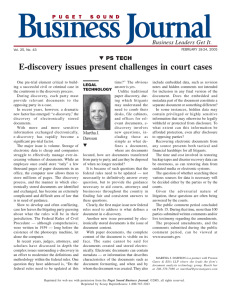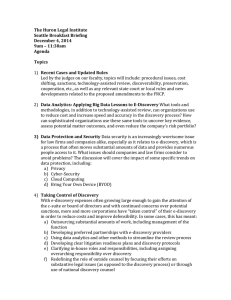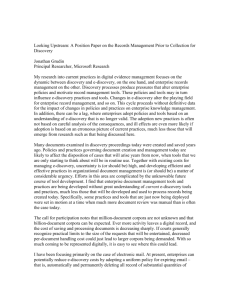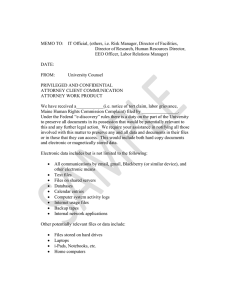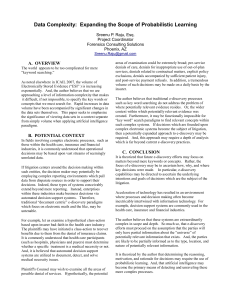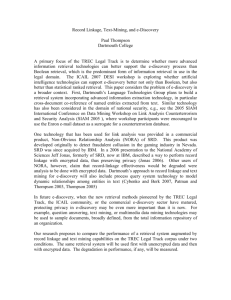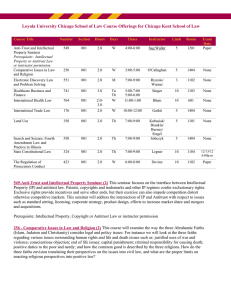Name of Project: E-Discovery Challenge ARC Project Number: KY-16403-C1-2010
advertisement
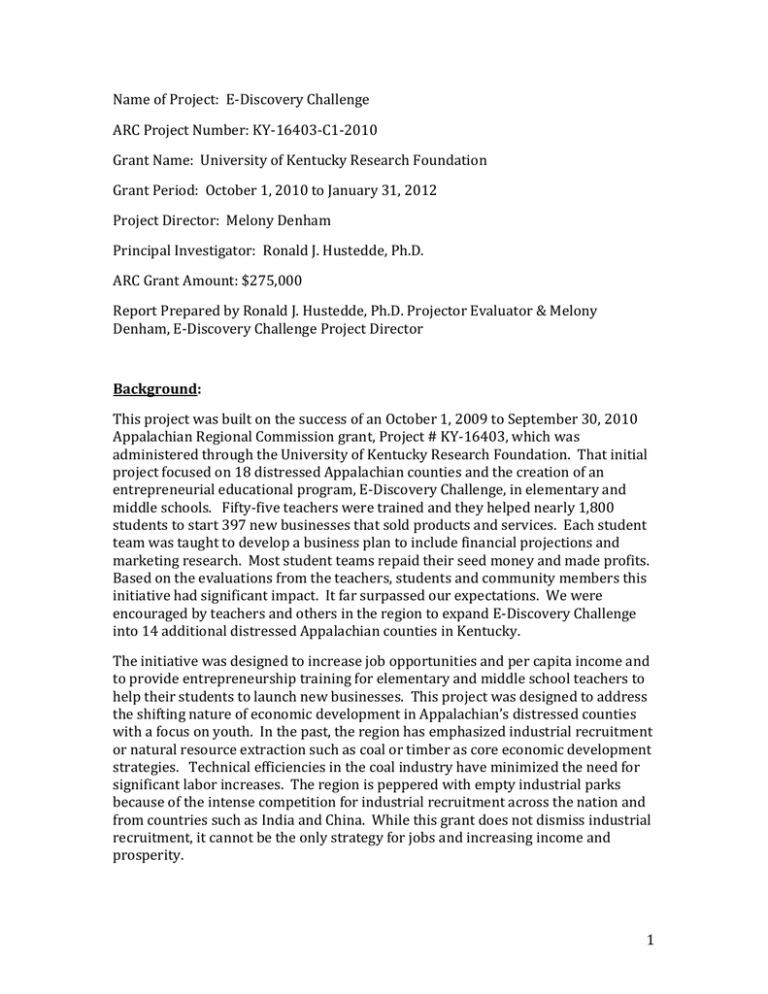
Name of Project: E-Discovery Challenge ARC Project Number: KY-16403-C1-2010 Grant Name: University of Kentucky Research Foundation Grant Period: October 1, 2010 to January 31, 2012 Project Director: Melony Denham Principal Investigator: Ronald J. Hustedde, Ph.D. ARC Grant Amount: $275,000 Report Prepared by Ronald J. Hustedde, Ph.D. Projector Evaluator & Melony Denham, E-Discovery Challenge Project Director Background: This project was built on the success of an October 1, 2009 to September 30, 2010 Appalachian Regional Commission grant, Project # KY-16403, which was administered through the University of Kentucky Research Foundation. That initial project focused on 18 distressed Appalachian counties and the creation of an entrepreneurial educational program, E-Discovery Challenge, in elementary and middle schools. Fifty-five teachers were trained and they helped nearly 1,800 students to start 397 new businesses that sold products and services. Each student team was taught to develop a business plan to include financial projections and marketing research. Most student teams repaid their seed money and made profits. Based on the evaluations from the teachers, students and community members this initiative had significant impact. It far surpassed our expectations. We were encouraged by teachers and others in the region to expand E-Discovery Challenge into 14 additional distressed Appalachian counties in Kentucky. The initiative was designed to increase job opportunities and per capita income and to provide entrepreneurship training for elementary and middle school teachers to help their students to launch new businesses. This project was designed to address the shifting nature of economic development in Appalachian’s distressed counties with a focus on youth. In the past, the region has emphasized industrial recruitment or natural resource extraction such as coal or timber as core economic development strategies. Technical efficiencies in the coal industry have minimized the need for significant labor increases. The region is peppered with empty industrial parks because of the intense competition for industrial recruitment across the nation and from countries such as India and China. While this grant does not dismiss industrial recruitment, it cannot be the only strategy for jobs and increasing income and prosperity. 1 Contemporary approaches of economic development argue that traditional approaches toward job creation must be balanced with entrepreneurship in order to reach parity with the nation. Today approximately 16% to 20% of the citizens in this region have their own businesses. If current trends continue, about 25% of adults in rural America will own a business by the year 2015. Small businesses continue to be a major source of employment in Kentucky. The literature about entrepreneurship suggests innovative small business can respond more quickly than the corporate sector to changing market needs regarding food safety and freshness, energy efficiency, new consumer trends such as interest in agricultural tourism, and other consumer, business, and governmental needs. Entrepreneurship requires a shift. It’s about encouraging innovative thinking, team work and building a culture which questions the status quo. This project was created because of the understanding that local economic development strategies must encourage and support youth because they are capable of making significant and long-term contributions in their community. Educational systems need to move away from the “get a job” mentality and working for someone else to situations in which youth entrepreneurs and innovators are the norm rather than the exception. Hence, it is essential that there be support programs which provide access to entrepreneurship training for elementary, middle school and high school students with clear expectations that they will start new businesses. Our purpose was to provide materials and incentive for 35-50 new teachers in 32 distressed rural Appalachian counties to expand or develop entrepreneurial talent among elementary and middle school students. The program was also designed to build student entrepreneurial teams who would conduct market research and sell their goods and services. We wanted them to develop financial projections in order to repay seed money and to make a profit. We also wanted them to reflect on the learning experience itself. Our other goal was to involve community in the process to validate youth and to learn and be inspired by them. Activities: October 2010 – December 2011 – Individual meetings and phone conversations were arranged with principals, assistant principals and teachers in the 15 original Appalachian counties that were involved with the program during the 2009-2010 school year. In addition, schools in the other 17 counties were also contacted and individual meetings were arranged with school administrators and teachers. October 2010 – We trained 14 additional elementary teachers from five counties to replace teachers that received E-Discovery training December 2010 and were transferred to other schools at the end of the school year. Teachers were from multiple school districts so the training was held in a central location. Teacher and student manuals were printed and shipped to all teachers trained in 2009 and 2010. 2 November 2010 – E-Discovery team attended the 28th Annual Entrepreneurship Education Forum held in Columbus, Ohio and presented E-Discovery Challenge during a session. The Forum was a great opportunity to network with leaders in the field of entrepreneurship from across the country and to learn about best practices. E-Discovery team members conducted recruitment of teachers in the 14 counties covered by expansion of the grant. Nearly 60 teachers were recruited for training; additional teachers are interested in taking training at a later date. November- December 2010 – E-Discovery team members attended student sales events in several counties. Some teachers have a new class of students each nine weeks so they are having a sales event after each class of students completes EDiscovery. This is extra work for the teachers that chose to do it this way, but they believe in the results of E-Discovery. December 2010 – Three regional workshops were scheduled for teachers, but these had to be cancelled due to dangerous winter road conditions and unexpected school closings. January 2011 – Five regional workshops were scheduled; two were held and three were cancelled due to dangerous road conditions and numerous school closings from snowfall. We worked with school administrators and teachers to determine the best time to reschedule E-Discovery workshops. Teacher and student manuals were printed and shipped to schools that have teachers trained and ready to incorporate E-Discovery curriculum into the classroom. February 2011 – Challenging weather conditions continued to cause school delays and cancellations. E-Discovery was on hold most of the month of February. March 2011 – Teachers began teaching E-Discovery in the classroom since school resumed on a regular basis due to improved weather conditions. We had a request from three elementary schools in Rockcastle County to conduct a training this month and they assured us they would complete E-Discovery before the end of the school year. April 2011 – Sales events were held at many schools near the end of this month and many of the students tied their businesses to Spring/Easter sales. Most made profits with their team businesses and were able to repay their seed money to their school for the sustainability of E-Discovery for the next school year. May 2011 – E-Discovery team attended sales events at schools to support the students and teachers. All schools completed E-Discovery by the end of the school year. At the end of the classroom experience, teachers attended a wrap-up session to report student progress with E-Discovery from the beginning through the sales event. One session was held in May and the others were scheduled in June. 3 June 2011 – Regional wrap-up sessions were held for teachers to share the impact of the E-Discovery experience on their students, what the impacts were for them as teachers and how the schools responded to the initiative. The reports from the teachers were very glowing and many of the teachers shared responses from the students on their exit surveys and writing prompts that were required throughout the learning process. The positive impact on students continues to be reported: increased self-esteem, creativity, autonomy, self-confidence and responsibility to name just a few. Students learned to work as a team to develop their businesses and carry out all the responsibilities throughout the E-Discovery learning process including the sales event and all the follow-up activities. July – August –September 2011 – Regional teacher trainings were conducted for new teachers in the distressed ARC counties in Northeastern and South Central Kentucky counties. They launched E-Discovery in the classroom during the 20112012 school year. Teachers trained to teach E-Discovery in the classroom in the previous grant have been great advocates to recruit additional teachers to be part of the initiative. Due to teachers beginning E-Discovery instruction at various times during the school year, some students had their businesses ready for sales events in December while many students set up their businesses at spring sales events. E-Discovery team members attended sales events and heard from students about their experiences. Students completed writing reflections after the sales events outlining what they learned about starting a business, how their team business worked and what they would have done differently. October 2011-December 2011 – Schools sponsored sales events for student team products and services. The parents and other community citizens were also involved at these events as purchasers. Melony Denham went to these events and visited with school administrators about the impact of E-Discovery. The feedback from teachers, staff, students and administrators was positive because the sales events brought the entrepreneurial teaching to fruition and energized students, teachers, administrators, parents and the community. November 2011 – Three E-Discovery teachers presented the lessons learned from E-Discovery at the 29th Annual Entrepreneurship Education Forum in Cincinnati, Ohio. The presentation affirmed the importance of teachers sharing their experiences about E-Discovery with others in the nation. January 2012 – Teachers responded to a lengthy survey about the impact of the program on their role as a teacher, learning needs of students and other issues associated with E-Discovery. Students wrote exit surveys and reflections about the initiative. Some also wrote letters to the Project Director. Consultants: Four consultants were involved with the project: 1) Annette Walters, a Fellow with the University of Kentucky program, the Kentucky Entrepreneurial Coaches Institute. Mrs. Walters is a trained financial consultant. She co-designed 4 and co-taught the pilot program for E-Discovery; 2) Ann DeSpain is a retired teacher who took part in the pilot program. She contacted many of the administrators and teachers in the region about getting involved in E-Discovery; 3) Jessica McNutt from Maysville Community & Technical College developed visual presentations and a Kentucky page on the Consortium for Entrepreneurship Education website; and 4) Jonathan Tubbs, a University of Kentucky graduate student and former teacher, wrote and categorized responses from the teachers during the E-Discovery Challenge focus groups regarding the evaluation of the program. PROJECT OUTPUT PROJECT OUTCOME Recruitment Output: Frequent one-onone meetings, phone conversations and electronic communications were conducted with teachers and administrators in the 32 distressed Appalachian counties about the advantages of entrepreneurship education and E-Discovery Challenge Recruitment Outcome: Elementary and middle school teachers indicated they wanted to take part in the EDiscovery Challenge program. Over 80 new teachers indicated they wanted to become involved in the program. They were from fifteen of the counties in the targeted area. Some counties did not participate because administrators believed that teachers were overwhelmed. In many cases, weather related issues, especially in the mountainous areas, prevented teachers from participating in the training. Curriculum Output: E-Discovery Challenge training manual was developed for teachers in the distressed Appalachian communities. The materials are sensitive to statemandated core content requirements, teacher needs for flexibility and access to lessons plans that could be incorporated into the classroom. Curriculum Outcome: Based on 2011 feedback from teachers and students, EDiscovery Challenge is a respected curriculum that is easy for elementary and middle school teachers to adapt for their classrooms. It engages students to think and act creatively, to form teams, to conduct market research and to create new products or services and sell them to the public. Teacher Incentives: Teachers received modest incentives to implement entrepreneurial instruction into the classroom and integrate it into the state’s core content educational requirements. Teachers also received a stipend to attend a wrap-up session at the end of the school year to discuss the Teacher Incentives: The program is sustainable because teachers have tools to integrate E-Discovery Challenge entrepreneurial instruction into the classroom. In many cases, teachers who moved from one district to another encouraged other teachers to become involved in the program to replace them. 5 lessons learned from the classroom experience. Student Involvement: Elementary and middle school students received the skills and knowledge to form businesses. They learned how to work in teams, brainstorm ideas, conduct market research and make financial projections to sell their products or services Seed Money: Student teams had access to seed money to assist with marketing and starting a new business. Teachers informed the teams that they were expected to view the seed money as an interest-free loan and that each team needed to generate sufficient income from sales so that seed money would be available for the next year’s class. Student Reflections and Feedback: At the conclusion of their sales events, students were asked to complete an exit survey about their business. They were also asked to provide independent written reflections about the impact of the entire program. Community Involvement: Community members were invited to events in which students would sell products and services. Teachers discouraged parents from donating supplies because they wanted to give the students a full entrepreneurial experience. Teachers provided extensive feedback in wrap-up retreats about the impact of the program. Student Involvement: Most of the teachers divided their classrooms into entrepreneurial teams. These teams generated product or service ideas, conducted marketed research and then sold and delivered their products and services. Two –thousand seventy-four students participated. They launched 507 new businesses. Seed Money: As students generated income from their business, the seed money was paid back to the classroom program so that seed money would be available for the next year’s class. According to feedback from the teachers, the teams were adamant about repaying their seed money. Over 95% of the seed money was returned. Most student teams made a profit and some generated significant income from their modest investment. Student Reflections and Feedback: After the sales events, students completed exit surveys about their businesses and the E-Discovery Challenge experience. They also wrote essays or letters to the E-Discovery director. Most students found the experience of idea generation, budgeting and teamwork to be challenging. Overwhelmingly, they recommended that E-Discovery Challenge should be continued and expanded further, including the high school level. Community Involvement: Students sold their products and services at community events which had significant attendance from parents, citizens, teachers and other students. Most student teams made a profit and some sold out of their product quickly. 6 Insights from Wrap-Up Sessions: Teachers that completed the program took part in one of the four focus groups to evaluate the impact of E-Discovery Challenge during the months of May, June and July 2011. Those teachers who did not complete a sales event until November or December 2011 completed an open-ended questionnaire in January 2012. There were several themes that emerged: Impact on Teachers: Teachers were surprised how the program created a space for them to be more flexible and to support the temporary chaos associated with student creativity. The wrap-up sessions captured the energy and enthusiasm of the teachers. It was a growth experience for them as they participated in one of the most creative endeavors in their professional lives. One teacher commented that it “was the best experience I have had in my 23 years as a teacher.” Another wrote “I was more creative than I thought.” Impact on Students: Two-thousand seventy-four students were involved in this program. The teachers reported that the students were energized by the opportunity to create a product or service and to make money. The students took ownership of their business model and seem eager to continue. They learned how to work in a group and became more aware of how economic principles, communications and math applied to their businesses. It also provided opportunities for new student leaders to emerge. There were a significant number of students who started out the process as modestly engaged in school. The process motivated them and teachers saw new and creative sides of their students that they had not realized existed. Most teachers indicated that they were surprised with student creativity. The teachers also commented that students were more excited about learning because of this real life experience. “My students couldn’t wait to get their binders out and learn each day. It was very exciting and encouraging.” The students were conscientious about repaying their seed money. Impact on School Administrators/Parents/Community Members: The program drew significant support from school administrators, parents and community members because it culminated in a student-led sales event of their products and services. Parents and community members were surprised that students were creative and could generate their own income without getting a conventional job. It provided a new vision and an economic alternative that seemed to energize parents and community members. One teacher wrote “I still have parents that tell me that E-Discovery was the best thing their child ever did in school.” While most school administrators were supportive of the program, one school leader decided to tell students what to produce and sell. While these products did sell, the students indicated that they felt disempowered by this decision because they had other creative ideas they wanted to pursue. 7 Success Stories: There was a plethora of success stories from teachers. They were surprised with student creativity and how they could find buyers for their ideas. For example, some students used discarded tobacco sticks to create Christmas trees that were sold out within 15 minutes. Other students created their own printing company or developed experiences such as throwing a ball at something for a prize. Other successes include: A class of special education students created their own games to market at sales day and excelled within the E-Discovery program. One teacher has always required that her 5th grade students learn how to count change. The E-Discovery program put this activity into a real world context and also gave the students the motivation to learn. This past year this teacher had the highest success rate for the counting change content than she has ever had. A group of students held their sales event around Valentine’s Day, so they decided to sell the experience of a romantic dinner out. A classroom was set up with dim lights, candles, and a nice dinner for two. One student got their family involved and the students and their siblings made walking canes out of branches. At the end, the student split the profit with their siblings. One group of girls decided to sell gold fish for their product. They were leery about whether or not they would be able to sell their entire product so they only started with 15 fish. At the day of the sale, the group sold out within 5 minutes and sent someone back to get 50 more and almost completely sold out of those as well. Can holders (cozies) were decorated for the sales day. Before the sale, however, one of the students suggested they put a soda in the can holder to sell as well. The product ended up selling out very quickly. A group of girls made tissue paper flowers to sell and in a “green” effort they utilized aluminum soda bottles as the vases and quickly sold out but were able to make more during their lunch period to sell more. Another group sold a photo experience. The photo booth had different costumes (kiddy pool with arm floaters) and the pictures were sold for a few dollars each. The group was very unsuccessful at the beginning of the sales day but as the other groups sold out of their products, more and more people wanted their picture made until the photo booth was the most successful business there. At one school, the parent participation was overwhelming and the support they offered made the sales day very successful and the parents enjoyed it and were able to see what their students were doing in the classroom. Marshmallow Shooter – PVC pipe made into a marshmallow gun for mini marshmallows then painted, gun and ammo sold separately. Sports Cards – Students could be photographed and have themselves put onto a card with their name and stats. 8 Popcorn – two groups were selling popcorn and one decided to sell pop with their popcorn to draw a crowd; this competitive selling example was an effective learning tool. Some teachers indicated that test scores rose that year and they attributed it to EDiscovery and its culmination in a Market Day experience in which the student teams sold their products and services. Essentially, it made economics and other subjects became more alive and applicable for the students. Math scores may have improved because students were required to learn how to count change which is part of the E-Discovery curriculum. Teachers also indicated that E-Discovery helped hidden talent to emerge from the students that appeared to be shy, quiet or unmotivated. The experience brought out leadership, creativity, research abilities and sales acumen. Students from some of the teams barely covered expenses while others reaped up to $200 per person after repaying their seed money. The reflections led some of the least successful students to conclude that their marketing research or plan was flawed. While this comparison may be somewhat painful, these life lessons helped the teams to analyze their situation and to prepare for next year. Curriculum Critiques: Teachers were asked to respond to three questions regarding the curriculum: What should be kept? What should be added? What should be changed or deleted? For the most part, teachers were quite satisfied with the curriculum because of its clarity and natural progression of ideas and exercises. Here are some ideas that emerged from those discussions: What Should Be Kept? o Everything included in the program o The market research o The reflections and reflective activity o The shopping trip for the students to buy supplies to make their products o Keep the seed money/ financial aspect of the program What Should Be Added? o Connection to new core standards o Curriculum for younger students o Information on sales taxes for the purchasing field trip o Video or resource showing the different products other schools have sold o Requirements for sales day for the teachers/administrators o Interview questions for students to interview entrepreneurs in the community o Team building exercises o Meetings and a contact sheet of other teachers doing the program 9 o Persuasion techniques/resources for elevator pitch examples and advertisements What Should Be Omitted? o Nothing, keep it all o Let the students choose groups, not delegated by the teacher o Counting change activity o Less statistics at the beginning or at least putting it in student friendly terms What will E-Discovery look like in your classroom during the 2011- 2012 school year? The teachers seemed to be enthusiastic about continuing the program during the next academic year. The seed money generated in the grant was returned by most of the student groups and that will give them working capital to fund other students in the years ahead. The following comments from one of the focus groups reflect some of the general sentiments of the teachers regarding this question: E-Discovery will look the same as the last 2 years, don’t change a good thing Incorporate into the curriculum more More detail in the notebook for the students Having more seed money for the students Groups will be smaller E-Discovery should be started earlier in the year Will go more in depth with the content What was your “aha” moment in the E-Discovery process? We asked teachers an open-ended question regarding their “aha” moment. The following responses from one of the focus groups reflect some key themes that are reflected in other parts of this report: Seeing the students have fun while learning and creating Seeing the ownership the students had Watching a student try to pay back seed money out of pocket Seeing the generosity of some of the students with money and their products for those who couldn’t afford full price Realizing the program works best when the teacher steps back and gives up control to the students Administrative support and assistance is key to a successful program The impact on the kids When the students were excited and motivated through the process of the program Seeing how creative and capable the students are 10 Outlook for Program Continuation and Sustainability: Teachers take E-Discovery training and receive seed money funds from the grant based on the number of students in their classroom. The seed money is used as loans to the students to develop their team businesses. Students repay the seed money to the school after the sales event is held. Each year the seed money is available for the students to start their businesses. With each participating school having E-Discovery seed money funds, the program is sustainable as long as they have teachers that are trained to implement E-Discovery in the classroom. Plans are to seek additional funding to expand E-Discovery throughout Kentucky. Conclusions and Recommendations from the E-Discovery Project Team: The team underestimated the amount of time it takes to recruit new teachers and to implement the program in the 32 county area. The project has exceeded our expectations and, in hindsight, we should have added more monies to the budget for additional labor to recruit more teachers and to serve the needs of those involved in the program. Teachers who took part in the 2009-2010 E-Discovery program were our most effective advocates in recruiting new teachers for the 2010-2011 school year. The E-Discovery teachers and community supporters who took part in the November 2011 Entrepreneurship Education Forum in Cincinnati, Ohio gained new ideas and a broader network. It would be helpful if this alliance could continue. We are grateful to the University of Kentucky Agricultural Communications Department. They are developing a video of the E-Discovery sales events and interviews with parents, teachers, students and administrator and the E-Discovery team. The video will be used to promote E-Discovery and to involve more teachers in the process. We believe it is appropriate to have a dialogue with the Kentucky Department of Education regarding the integration of E-Discovery into classrooms across the state. How can this experience be helpful to others in the Appalachian region? Other entrepreneurial educational programs do not necessarily lead to the creation of new businesses. E-Discovery Challenge is more potent because it provides the tools for students to actually launch new businesses. Students learn about brainstorm and creativity. They learn how to focus their ideas and then to conduct market research and make financial projects and how to market and sell their product or service. They repay their seed money and learn how to make a profit. They also write about their experiences after their sales event. In essence, it makes education more visceral and exciting for students and the sales events inspires parents, teachers, and administrators. 11 Seed money is essential for starting a new business. That is why it is important to set aside monies for each student with the understanding that those students will repay those monies to replenish the fund for future classes. Team work is part of success. The most successful entrepreneurs do not work alone. Rather they are part of an entrepreneurial team which builds on the unique strengths of each individual on the team. It is quite clear that the adage about teachers being overworked and underpaid is quite accurate. They do not need more responsibilities. We addressed these concerns by paying a modest stipend to teachers for taking part in a one-day training workshop to implement the program. We also paid them a modest amount to take part in a one-day wrap-up session and to complete an open-ended questionnaire regarding the impact of the program. Administrators are concerned about finding monies for substitute teachers while teachers took part in our one-day training program and orientation. We incorporated this concern into our budget. We also provided training on Saturday or during the summer to minimize the need to pay substitute teachers. Overall, E-Discovery Challenge builds the skills necessary for elementary and middle school students to start entrepreneurial ventures. It provides the imagination, hope and economic opportunities for a distressed region. It merits expansion throughout Appalachia. 12
